Abstract.
Deep-seated meta-igneous xenoliths brought to the surface by alkali basaltic magmas from the Kerguelen Islands reveal that basaltic magmas have intruded the upper mantle throughout their geological evolution. These xenoliths record volcanic activity associated with their early South East Indian Ridge location and subsequent translation to an intraplate setting over the Kerguelen Plume. The meta-igneous xenoliths sample two distinctive geochemical episodes: one is tholeiitic transitional and one is alkali basaltic. Geothermobarometry calculations provide a spatial context for the rock type sequence sampled and for interpreting petrophysical data. The garnet granulites equilibrated over a pressure range of 1.15 to 1.35 GPa and the garnet pyroxenite at 1.8 GPa. Ultrasonic measurements of compressional wave speed VP have been carried out at pressures up to 1 GPa, and densities measured for representative samples of meta-igneous xenoliths and for a harzburgite that represents the peridotitic mantle. VP and density have also been calculated using modal proportions of minerals and appropriate elastic properties for the constituent minerals. Calculated and measured VP agree well for rock types with microstructures not complicated by kelyphitic breakdown of garnet and/or pervasive grain-boundary cracking. Pyroxene granulites have measured and calculated VP within the range 7.37–7.52 km/s; calculated velocities for the garnet granulites and pyroxenites range from 7.69 to 7.99 km/s, whereas measured and calculated VP for a mantle harzburgite are 8.45 and 8.29 km/s respectively. The seismic structure observed beneath the Kerguelen Islands can be explained by (1) a mixture of underplated pyroxene granulites and ultramafic rocks responsible for the 2–3 km low velocity transitional zone below the oceanic layer 3, (2) varying proportions of granulites and pyroxenites in different regions within the upper mantle producing the lateral heterogeneities, and (3) intercalation of the granulites and pyroxenites throughout the entire upper mantle column, along with elevated temperatures, accounting for the relatively low mantle velocities (7.70–7.95 km/s).
Similar content being viewed by others
Author information
Authors and Affiliations
Additional information
Electronic Publication
Rights and permissions
About this article
Cite this article
Grégoire, .M., Jackson, .I., O'Reilly, .S. et al. The lithospheric mantle beneath the Kerguelen Islands (Indian Ocean): petrological and petrophysical characteristics of mantle mafic rock types and correlation with seismic profiles. Contrib Mineral Petrol 142, 244–259 (2001). https://doi.org/10.1007/s004100100289
Received:
Accepted:
Issue Date:
DOI: https://doi.org/10.1007/s004100100289




